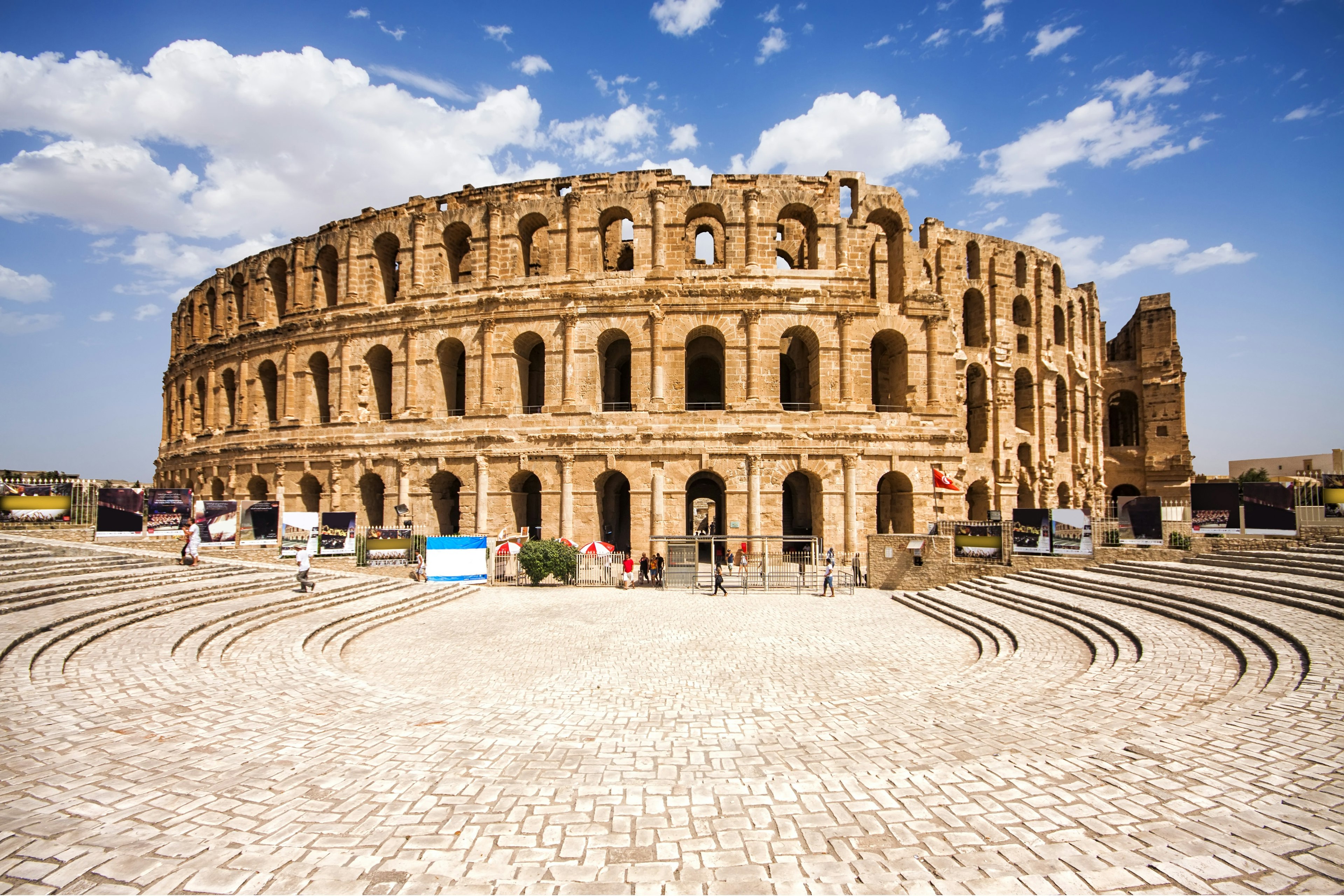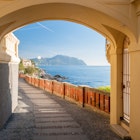

Even on a short trip you should have time to visit the village of Sidi Bou Saïd. Getty Images
Tunisia has long been a destination for sun seekers but this North African country within arm’s length of the Italian island of Sicily has much more than beaches of golden sand.
Despite its small size, Tunisia shelters many treasures recognized by UNESCO – eight cultural sites and a national park. This is in addition to a plethora of historical monuments and towns full of architectural wonders which reveal the country’s fascinating mix of Berber, Phoenician, Roman, Byzantine, Arab, and French influences.
Tunisia also stands out for the diversity of its landscape. The lush hills and agricultural plains of the north make way for endless rows of olive groves in the center of the country, while the arid south is painted with mystical desert vistas.
Exciting new initiatives in sustainable and cultural tourism have sprung up in recent years, enticing visitors away from the beach resorts and into spice markets, olive groves, wineries, and artisans’ workshops to sample °Õ³Ü²Ô¾±²õ¾±²¹â€™s many gastronomic delights and learn about its traditional handicrafts.
Tunisia is also easy on the wallet for those traveling on a budget, with plenty of upscale options for those who prefer a spot of luxury.

When should I go to Tunisia?
Summer is peak season when beachside resorts fill up with sun-seeking tourists. This is also the hottest time of year, with average temperatures rising to the mid-30℃ (mid-90s ℉). Days are a bit cooler in the spring and autumn – consider a visit during these seasons if you plan to explore the sights. Even in winter, temperatures remain relatively mild, especially in the south where days are warm, but nights can get nippy.
Summer is also when music lovers flock to the international festivals of Carthage, Hammamet, Sousse and Dougga which showcase open air concerts in atmospheric settings.
During the holy month of Ramadan, restaurants and cafes close their shutters during the day but reopen at nightfall after the breaking of the fast, often until the small hours. Though everyday life slows down, visiting during Ramadan provides the chance to experience the nightly festive atmosphere.
How much time should I spend in Tunisia?
If you have only a weekend, two to three days could be enough for a quick introduction to Tunis as well as the chic coastal city of La Marsa, and romantic Sidi Bou Saïd, both situated on the outskirts of the capital.
But at least a week is needed to browse the souqs and markets of Tunis’ 7th century medina, explore the vast archaeological site at , and take a beach break in Hammamet followed by a seafood lunch at a waterside bistro. This also leaves time to shop for traditional ceramics in Nabeul, or a side trip to take in the ruins of ancient Roman Dougga.
With 10 days to two weeks, you can make your way to Sousse to discover its historical 9th century medina, marvel at the great mosque of , and the magnificent Roman amphitheater at El Jem. Head further south for a break on the sandy beaches of the island of Djerba before rounding off your Tunisian adventure in the desert landscapes of the south.

Is it easy to get to and around Tunisia?
Tunis-Carthage is °Õ³Ü²Ô¾±²õ¾±²¹â€™s main airport with direct flights to many cities in Europe, North Africa, and the Middle East. Seasonal flights bring holidaymakers from Europe to the airports of Monastir Habib Bourguiba, Enfidha-Hammamet, and Djerba-Zarzis. Consider flying into one airport and out of another to cut down on travel time.
Ferries sail year-round to Tunis from Marseille (22 hours) and Palermo (11 hours), while summer services also link Tunis to Civitavecchia (Rome) and Genova, and Zarzis in the south with Marseille and Tripoli, Libya.
Tunisia is a small country with an extensive road network that makes getting around by car the most efficient way to travel. Book a car with one of the rental companies operating at the airport or via a local tourist agent.
Trains run as far south as Gabes and Tozeur in the west, but rail travel is a lot slower and less reliable than public buses which are inexpensive and air-conditioned to boot.
°Õ³Ü²Ô¾±²õ¾±²¹â€™s louage system is the most convenient and cost effective way to travel. These white minibuses, operating as share-taxis, set off for their destination once all eight seats are taken and paid for. Each city has a dedicated louage station.
Metered taxis operate only within the urban area they’re licensed for and are generally very good value at less than 1DT per kilometer. You can also book a cab using the or apps but fares are slightly more expensive.

Top things to do in Tunisia
Scattered over an area of 3kms, the UNESCO-listed archaeological site of Carthage is chock full of age-old ruins dating to Phoenician, Punic, and Roman times, as well as a jumble of Paleochristian and Arab relics. The most impressive remains of this sea-facing ancient city, once an important commercial center, include the semi-circular Roman amphitheater, the arched walls of the Roman Antonine Baths, and the reconstructed Villa of the Aviary.
It’s an easy side-trip from Tunis to picture-perfect Sidi Bou Said, set on a cliffside overlooking the Gulf of Tunis. It’s a delight to wander its cobblestone streets lined with whitewashed villas punctuated with bright blue doors and windows. Then pause for a glass of mint tea at Café des Nattes or take in the sweeping sea views from the terrace of Café des Délices.
Explore the medinas of Tunis and Sousse, both listed by UNESCO as World Heritage sites, to get a feel for typical Arabo-Muslim architecture. Inside these walled mini-cities you’ll come across a labyrinth of lanes opening onto squares and courtyards, imposing mansions, centuries-old mosques, and buzzing bazaars and souqs.
Head into the desert landscapes of °Õ³Ü²Ô¾±²õ¾±²¹â€™s deep south to explore Star Wars film sets, followed by a camel trek through sandy dunes. Here you can get close to Berber culture, spend a night in troglodyte cave dwellings, or camp in the desert.
Get to know Tunisia through your taste buds by joining a market tour or cooking class with. Browse spice markets, learn about flower distillation techniques, and sample °Õ³Ü²Ô¾±²õ¾±²¹â€™s exquisite harissa, olive oil, and typical delicacies such as mlawi, a flaky flatbread, or brik, a deep-fried pastry stuffed with egg and tuna.
My favorite thing to do in Tunisia
Instead of staying at a generic hotel, I love to overnight at typical Tunisian dars, traditional houses which have been converted into bed and breakfast-style accommodation. These rambling mansions with open-air courtyards at their center, are often tucked away in the narrow lanes of historic medinas. Their thick walls provide a quiet respite from the urban hustle and bustle, and are decorated with exquisite examples of traditional handiwork: hand-painted ceramic tiles gracing walls and floors, columns carved out of stone or wood, and original metalwork.
has two locations (rue du Pacha and Rue El Kahia) in the heart of Tunis’ medina. Both houses have been lovingly restored and their traditional aesthetics preserved. A collection of vibrant art works and ceramics add to their old world charm, but what draws me back are the upper floor libraries full of cozy corners and a carefully curated collection of art and history books.

How much money do I need for Tunisia?
Accommodation will eat up the majority of your travel budget in Tunisia but you can keep in-country travel costs low. Prices for food and drink can vary from very affordable to pricey, depending on the locale.
hostel room: 20DT
basic room for two: 70DT
self-catering apartment (including Airbnb): 70DT
public transport ticket: 0.50DT-0.80DT
cup of coffee: 1.30DT-6DT
glass of mint tea: 1.20DT-8DT
sandwich: 5DT-10DT
dinner for two: 25DT
beer/pint at the bar: 5DT
Do I need a visa for Tunisia?
Most travelers can stay in Tunisia visa-free for up to 90 days.
Which languages are spoken in Tunisia?
Standard Arabic is the national language but Tunisia has its own distinct dialect. As a former French protectorate, French is largely spoken while many young people increasingly prefer to speak English instead.
Explore related stories







 Local VoicesItaly vs Croatia: which Mediterranean country is right for you?
Local VoicesItaly vs Croatia: which Mediterranean country is right for you?Jun 13, 2024 • 8 min read
 Tips & Advice3 of this summer's best under-the-radar vacation spots in Italy
Tips & Advice3 of this summer's best under-the-radar vacation spots in ItalyMay 24, 2024 • 4 min read


